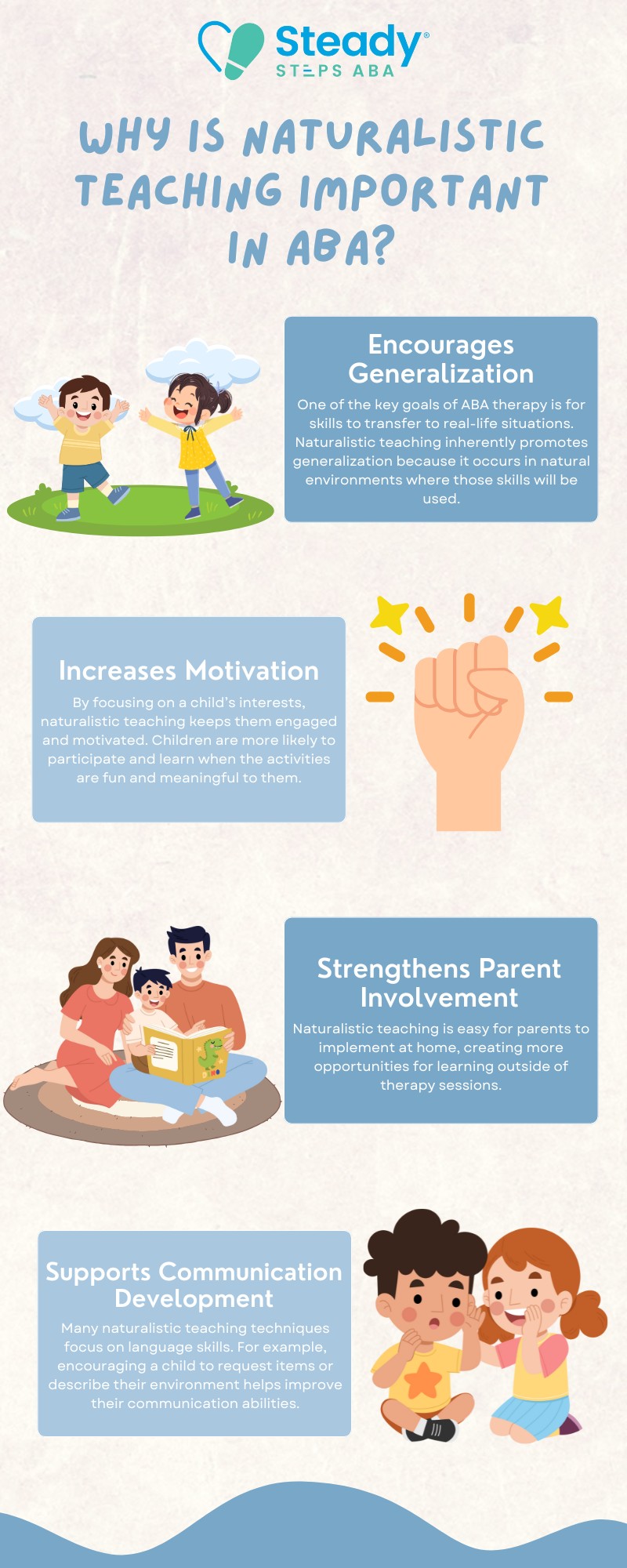Key Points:
- Naturalistic teaching in ABA uses everyday situations and child-led activities to teach skills.
- It promotes generalization by focusing on natural environments and meaningful contexts.
- Parents can use naturalistic teaching strategies to reinforce ABA therapy goals at home.
Applied Behavior Analysis (ABA) is a well-established approach to teaching children with autism. One of its most effective strategies is naturalistic teaching, which takes learning out of structured environments and integrates it into everyday life. It empowers parents and therapists to make therapy more engaging and functional. But what is naturalistic teaching in ABA, and how does it work? Let’s explore this child-focused teaching method.
What is Naturalistic Teaching in ABA?
Naturalistic teaching in ABA is an evidence-based strategy that uses everyday interactions and activities to teach skills in a child’s natural environment. It focuses on the child’s interests and creates meaningful learning opportunities embedded in daily routines.
Unlike more structured approaches, naturalistic teaching happens during play, meals, or other daily routines. For example:
- During snack time, a child might practice requesting items like “juice” or “crackers.”
- While playing with cars, a therapist might work on labeling colors or taking turns.
- At the park, a parent could teach a child to initiate interactions by saying, “Can I play too?”
This teaching style emphasizes generalization, ensuring skills learned in therapy carry over into real-world situations.

How Does Naturalistic Teaching Work?
Naturalistic teaching is child-led, flexible, and rooted in real-life contexts. This method ensures that learning is meaningful and functional, promoting both engagement and long-term success. Here’s how it typically works:
- Child-Led Activities
Therapists and parents follow the child’s lead, focusing on their current interests and motivations. If a child loves dinosaurs, for instance, lessons might involve counting toy dinosaurs or identifying their colors. - Incorporating Teaching into Daily Routines
Skills are taught during regular activities, such as eating, playing, or going for a walk. This makes learning feel less like therapy and more like a natural part of life. - Using Reinforcements Naturally
Instead of artificial rewards, naturalistic teaching uses real-life outcomes as reinforcements. For example, if a child requests a toy correctly, they receive the toy as a reward. - Building on Existing Skills
Therapists focus on small, manageable goals, gradually building upon the child’s strengths to introduce new skills.
Naturalistic teaching is especially effective for skill generalization. Unlike structured methods, it adapts to the child’s interests and natural environment, fostering engagement and meaningful learning that seamlessly integrates into daily life.

Techniques Used in Naturalistic Teaching
Learning about techniques used in naturalistic teaching benefits parents by empowering them to actively participate in their child’s skill development. These techniques are simple to implement during everyday activities, like playtime or mealtime, making learning a natural and consistent part of the child’s routine.
- Mand-Model Approach
- The therapist models the desired behavior or communication.
- The child is encouraged to imitate or respond, with reinforcement provided immediately.
- Incidental Teaching
- Opportunities for learning arise naturally during everyday activities.
- The therapist prompts the child to practice a skill when the opportunity presents itself, such as asking for help with a toy.
- Time Delay
- The therapist waits briefly after giving a cue to encourage the child to respond independently.
- For instance, placing a favorite toy just out of reach can motivate the child to request it.
- Environmental Arrangement
- The environment is organized to create opportunities for learning.
- For example, placing desired items on a high shelf encourages the child to ask for assistance.
- Natural Reinforcement
- Rewards are directly related to the activity, such as giving the child the requested item or continuing a fun game.
These techniques make naturalistic teaching adaptable to various goals, including communication, social interaction, and daily living skills.
How Can Parents Use Naturalistic Teaching at Home?
Parents play a vital role in naturalistic teaching. Here are a few ways to incorporate this approach into your home routine:
- Follow Your Child’s Lead
Observe what your child is interested in, whether it’s dinosaurs, trains, or drawings. Use those interests to teach new skills. - Be Consistent
Make naturalistic teaching a regular part of your day. Repetition is key to reinforcing skills. - Celebrate Successes
Use natural reinforcements to reward your child. If they ask for a snack appropriately, give it to them with praise. - Collaborate with Therapists
Work with your ABA team to identify goals and strategies for naturalistic teaching. This ensures consistency across therapy and home settings.
Partner with Steady Steps ABA
Understanding what naturalistic teaching is in ABA can help parents and therapists create meaningful learning opportunities for children with autism. By focusing on everyday interactions and child-led activities, this approach fosters engagement, skill development, and long-term success.
At Steady Steps ABA, we specialize in implementing naturalistic teaching strategies tailored to your child’s unique needs. Whether at home, in the community, or during therapy sessions, our experienced team is here to support your child’s growth.
Reach out to us today to discover how our ABA therapy in Maryland can help your child flourish!






